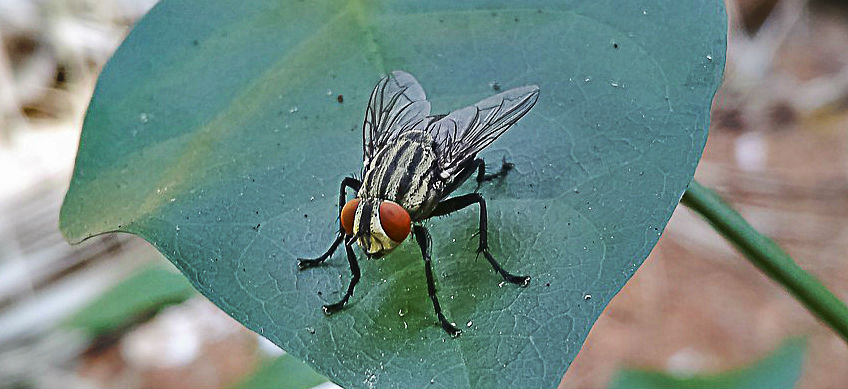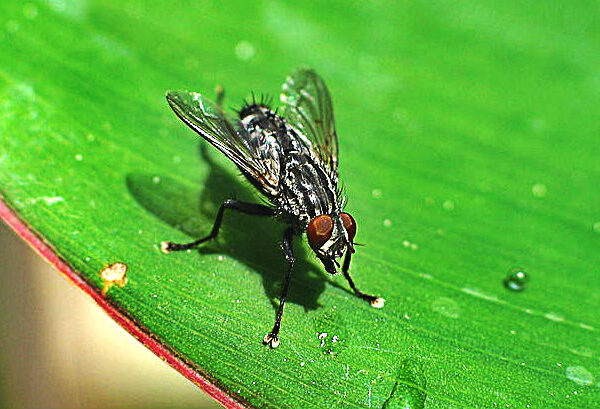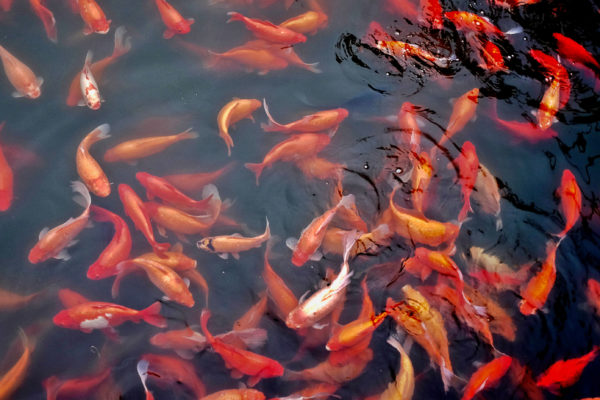
House fly larvae as fish feed in the EU
03.12.2017 / Scienceandmore / Category: Animal Biology
The house fly (HF) (scientifically Musca domestica) is another insect that can be used to convert organic wastes into high protein animal feed.
Mature house flies are greyish in colour, covered in hair, and around 6 to 7 mm long. In general, they live 15 to 25 days. Four to 20 days after copulation, female HFs lay around 500 eggs spread across a couple of days, often into moist substrate such as manure or garbage heaps. Whitish larvae hatch from these eggs within eight to 20 hours after ovipositon (egg deposition). House fly larvae (HFL) immediately start to feed on the present organic material, and require four to 30 days to complete their larval stage and enter pupation, depending on temperature and nutrient availability. Pre-pupal larvae are approximately three to nine mm in length and weigh around 13 mg (1,2).

Pros and Cons of house flies for animal feed production
An advantage of HF is that females lay a large amount of eggs; approximately 500 eggs in the wild and more than 2000 eggs in the controlled environment of the lab. Accompanied by the completion of their larval stage within four days under optimal conditions, HFs seem to be suited for a rapid production of larvae for animal feed production. Similar to BSF, the pre-pupa larval stage is commonly utilised for animal feed production.
HFL can grow on a wide range of organic substrates, including nutrient-poor cow manure, suggesting that they are relatively frugal. This characteristic could be used to turn organic wastes or low-quality substrates into high quality protein for animal feed, as well as nutrient rich fertilisers. HFL also require only small amounts of substrate for feeding, partly due to their fast life cycle. Around 1500 larvae have been reared on around 450 g of fresh manure.
In many studies, animal manure has been used as substrate for HFL. Interestingly, investigations showed that HFL feed on microbes that can be found in great numbers on manure. It has been hypothesised that the actual feed for HFL are microbes and not so much the manure itself (2,3). This, however, could relativise the utilisation of HFL for fish feed production in the EU due to the restrictions for substrates according to EU legislation. Approved substrates could be wheat bran for example. This substrate, however, would potentially not host enough microbes to effectively nourish HFL. Eventually, further investigations are needed to confirm this hypothesis.
The migration behaviour of HFL for pupation could be used for self-collection, similar as it has been proposed for BSFL. However, opinions differ on this topic, since it has been found that HFL grow in manure, pupate directly there and emerged as adult flies without migration to dryer spaces upon pupation. Thus, other collection methods that utilise mesh could be used. Here, the substrate with larvae is spread in a thin layer on the mesh and is subsequently exposed to light. HFL are photophobic and will try to escape the light by migration through the mesh into a container placed below (2,3).
The possession of mouth parts of adult HF and their requirement to feed is regarded as a disadvantage. Adult HF externally liquefy their feed via saliva, which is considered to be the time of possible pathogen transmissions. HF are considered as a pest and carriers of diseases due to this feeding mechanisms, however, no pathogen contamination of fish via HFL meal has been reported (2,4).
HFL also require temperatures between 25 °C and 32 °C, and a high humidity between 60 % and 75 % for optimal growth and development. This could necessitate additional temperature and humidity control, especially during the colder months of the year (1,3).
Hands-on experience found a strong unpleasant odour emerging at the rearing site of HFL. Pests could potentially be attracted to the rearing site when it is situated outside. The odour could also be a nuisance for adjacent neighbours, especially during summer months. Therefore, it could be more suitable to rear HFL in a controlled indoor environment with forced ventilation and gas cleaning.
Nutrient composition of house fly larvae
The nutrient content of HFL varies based on their rearing substrate. Generally, HFL consists of 40 % to 60 % crude protein (which is lower than fishmeal with around 65 % crude protein). The quality of the crude protein is determined by its amino acid (AA) balance. Since fish in aquaculture are mostly omnivorous and carnivorous, and are known to prey on other fish, the AA profile of a fish feed should be oriented towards the profile of fishmeal. Compared to fishmeal, HFL meal has a modestly lower amount of the AAs isoleucine, leucine, and lysine. It has often been suggested to supplement the AAs that are low in concentration in order to bring the AA profile of insect meal up to par with the one of fishmeal. This approach, however, was objected to and no addition of AA has also been proposed (2). Eventually, investigations in different fish species, accompanied by economic calculations, would be necessary to clarify if an AA supplementation is appropriate or even needed.
The lipid content of HFL is also dependent on their rearing substrate, but is generally between 9 % to 26 %. It has been found that more than half (around 57 %) of the HFL oil of larvae reared on cow manure consists of monounsaturated fatty acids; saturated fatty acids form the second largest amount (around 38 %). This HFL oil is low in polyunsaturated fatty acids (4 %), specifically in omega-3 fatty acids (less than 1%). This could be problematic for fish in aquaculture due to their inability to synthesise essential fatty acids like omega-3 fatty acids. The fatty acid profile of BSFL has already been indicated to affect its utilisation in certain fish species. Therefore, it has been suggested to add omega-3 fatty acids by ways of algae for example (2). This approach, however, is questionable.
The phosphorus content in HFL is high (nine to 24 g per kg dry mass) and similar to the one of BSF. However, HFL contain significantly less calcium than BSFL (three to eight g per kg dry mass). Overall, phosphorous and calcium levels are lower than in fishmeal (but higher than in soy). Calcium could be added to HFL meal to improve the calcium:phosphorous ratio. This, however, seems to depend on the fish species the HFL meal is intended for. Several fish species have been shown to obtain calcium directly from water and do not depend on calcium intake from their feed (3,4,5).

House fly larvae meal in fish feed
Similar to BSFL, only few investigations have been conducted on the use of HFL as fish feed, and even fewer specifically in fish species that are reared in the EU.
In a 25 days trial, meal from HFL that were cultivated on hen manure could replace 100 % of fishmeal (30 % dietary inclusion) in the diet of common carp without detrimental effects on the digestibility of the fish feed (6).
During a nine weeks trial in rainbow trout, replacement of 25 % of fishmeal with HF pupae meal (larvae were reared on cow manure) resulted in reduced growth of trout. This, however, is stated with the caveat that the control group consumed more calories than the replacement diet group, due to a calculation error made during the diet formulation, that could have contributed to the differences in feed conversion between groups. The lipid content in the fillet of trout fed with HF pupae meal was slightly lower than the one of fishmeal-fed trout. However, the fatty acid profile of HF pupae meal-fed trout showed reduced levels of healthy omega-3 fatty acids (7). This result has already been observed in BSFL meal-fed fish, and a strategy of applying a finishing diet for rainbow trout has been suggested.
In other fish species such as Nile tilapia (Oreochromis niloticus) and African catfish (Clarias gariepinus), HFL meal up to a dietary inclusion of 25 %, which represents around 35 % to 100 % replacement of fishmeal according to different studies, resulted in similar fish growth as diets with fishmeal. Here again, the fish were low in omega-3 fatty acids (3,8).
Research on the utilisation of HFL meal in feed for fish that are mainly reared in the EU is still in its early stages. Future investigations could aim to determined how much dietary inclusion of HFL meal is tolerated by these fish species, as well as if defatted HFL meal in the feed affects fish performance, as suggested by findings in BSFL. Here, it was found that when BSFL are reared on a mixture of cow manure and fish offal, instead of cow manure alone, no effects on rainbow trout performance was observed, whereas the sole use of cow manure resulted in BSFL meal that lead to reduced trout growth (9).
References
1. Sanchez-Arroyo, H., Capinera, J.L. (2017) House fly: Musca domestica. [online] Featured Creatures. Available at: http://entnemdept.ufl.edu/creatures/urban/flies/house_fly.HTM [Accessed: 04.11.2017].
2. Hussein, M., Pillai, V. V., Goddard, J. M., Park, H. G., Kothapalli, K. S., Ross, D. A., et al. (2017) Sustainable production of housefly (Musca domestica) larvae as a protein-rich feed ingredient by utilizing cattle manure. PLoS ONE, 12(2), e0171708.
3. Makkar, H.P.S., Tran, G., Heuzé, V., Ankers, P. (2014) State-of-the-art on use of insects as animal feed. Animal Feed Science and Technology, 197, 1-33.
4.NCIPMI (1998) Insect and related pests of man and animals. North Carolina Integrated Pest Management Information. [online] Available at: http://ipm.ncsu.edu/AG369/notes/black_sol-dier_fly.html [Accessed: 05.11.2017]
5. Simkiss, K. (1974) Calcium metabolism of fish in relation to aging. In Aging of Fish (Ed. by Begenal, T.B., pp. 1-12. Unwin Brothers, Woking.
6. Ogunji, J., Pagel, T., Schulz, C., Kloas, W. (2009) Apparent digestibility coefficient of housefly maggot meal (magmeal) for Nile tilapia (Oreochromis niloticus L.) and carp (Cyprinus carpio). Asian Fisheries Science. 22: 1095-1105.
7. St-Hilaire, S., Sheppard, C., Tomberlin, J.K., Irving, S., Newton, L., McGuire, M.A., Mosley, E.E., Hardy, R.W., Sealey, W. (2007) Fly prepupae as a feed stuff for rainbow trout, Oncorhynchus mykiss. J. World Aquacult. Soc. 38:59-67.
8. Tran, G., Heuzé, V., Makkar, H.P.S. (2015) Inserts in fish diets. Animal Frontiers 5(2): 37-44.
9. Henry, M., Gasco, L., Piccolo, G., Fountoulaki, E. (2015) Review on the use of insects in the diet of farmed fish: Past and future. Animal Feed Science and Technology, 203:1-22.
